【雕爷学编程】Arduino动手做(136)---0.91寸OLED液晶屏模块5
37款传感器与执行器的提法,在网络上广泛流传,其实Arduino能够兼容的传感器模块肯定是不止这37种的。鉴于本人手头积累了一些传感器和执行器模块,依照实践出真知(一定要动手做)的理念,以学习和交流为目的,这里准备逐一动手尝试系列实验,不管成功(程序走通)与否,都会记录下来—小小的进步或是搞不掂的问题,希望能够抛砖引玉。
【Arduino】168种传感器模块系列实验(资料代码+仿真编程+图形编程)
实验一百三十六:0.91寸OLED液晶屏显示模块 IIC 12832液晶屏 兼容3.3v-5V
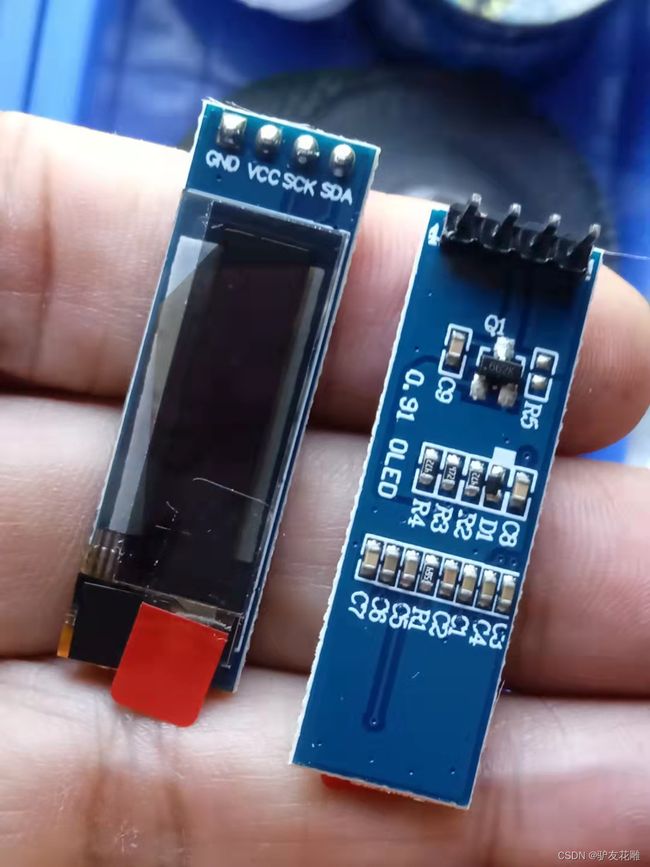
【Arduino】168种传感器模块系列实验(资料代码+仿真编程+图形编程)
实验一百三十六:0.91寸OLED液晶屏显示模块 IIC 12832液晶屏 兼容3.3v-5V
项目十九:OLED屏显示时钟
实验开源代码
/*
【Arduino】168种传感器模块系列实验(资料代码+仿真编程+图形编程)
实验一百三十六:0.91寸OLED液晶屏显示模块 IIC 12832液晶屏 兼容3.3v-5V
项目十九:OLED屏显示时钟
实验接线:
oled模块 Ardunio Uno
GND---------GND接地线
VCC---------5V 接电源
SDA---------A4
SCL ------- A5
*/
#include "ssd1306.h"
uint32_t lastMillis;
uint8_t hours = 10;
uint8_t minutes = 02;
uint8_t seconds = 0;
void printSeconds() {
if (seconds & 1) {
ssd1306_printFixed(54, 2, ":", STYLE_NORMAL);
}
else {
ssd1306_printFixed(54, 2, " ", STYLE_NORMAL);
}
}
void printMinutes() {
char minutesStr[3] = "00";
minutesStr[0] = '0' + minutes / 10;
minutesStr[1] = '0' + minutes % 10;
ssd1306_printFixed(78, 2, minutesStr, STYLE_NORMAL);
}
void printHours() {
char hoursStr[3] = "00";
hoursStr[0] = '0' + hours / 10;
hoursStr[1] = '0' + hours % 10;
ssd1306_printFixed(6, 2, hoursStr, STYLE_NORMAL);
}
void setup() {
//如果您需要使用 128x32 显示,请将下面的行替换为 ssd1306_128x32_i2c_init()
ssd1306_128x32_i2c_init();
ssd1306_fillScreen(0x00);
ssd1306_setFixedFont(comic_sans_font24x32_123);
lastMillis = millis();
printHours();
printMinutes();
}
void loop() {
if ((uint32_t)(millis() - lastMillis) >= 1000) {
lastMillis += 1000;
if (++seconds > 59)
{
seconds = 0;
if (++minutes > 59)
{
minutes = 0;
if (++hours > 23)
{
hours = 0;
}
printHours();
}
printMinutes();
}
printSeconds();
}
}
Arduino实验场景图

【Arduino】168种传感器模块系列实验(资料代码+仿真编程+图形编程)
实验一百三十六:0.91寸OLED液晶屏显示模块 IIC 12832液晶屏 兼容3.3v-5V
项目二十:OLED屏显示自动翻滚文本字符
实验开源代码
/*
【Arduino】168种传感器模块系列实验(资料代码+仿真编程+图形编程)
实验一百三十六:0.91寸OLED液晶屏显示模块 IIC 12832液晶屏 兼容3.3v-5V
项目二十:OLED屏显示自动翻滚文本字符
实验接线:
oled模块 Ardunio Uno
GND---------GND接地线
VCC---------5V 接电源
SDA---------A4
SCL ------- A5
*/
#include "ssd1306.h"
#include "ssd1306_console.h"
void setup() {
/* Replace the line below with the display initialization function, you want to use */
ssd1306_128x32_i2c_init();
ssd1306_clearScreen();
/* Set font to use with console */
ssd1306_setFixedFont(ssd1306xled_font6x8);
}
void loop() {
ssd1306_print( "Hello World\n" );
delay(500);
ssd1306_print( "Life is toss\n" );
delay(500);
}
Arduino实验场景图

【Arduino】168种传感器模块系列实验(资料代码+仿真编程+图形编程)
实验一百三十六:0.91寸OLED液晶屏显示模块 IIC 12832液晶屏 兼容3.3v-5V
项目二十一:自动计数器
实验开源代码
/*
【Arduino】168种传感器模块系列实验(资料代码+仿真编程+图形编程)
实验一百三十六:0.91寸OLED液晶屏显示模块 IIC 12832液晶屏 兼容3.3v-5V
项目二十一:自动计数器
实验接线:
oled模块 Ardunio Uno
GND---------GND接地线
VCC---------5V 接电源
SDA---------A4
SCL ------- A5
*/
#include "ssd1306.h"
#include "ssd1306_console.h"
Ssd1306Console console;
void setup(){
/* Replace the line below with the display initialization function, you want to use */
ssd1306_128x32_i2c_init();
ssd1306_clearScreen();
/* Set font to use with console */
ssd1306_setFixedFont(ssd1306xled_font6x8);
}
void loop(){
static uint8_t i = 0;
/* Here use any methods, provided by Arduino Print class */
console.print("Line ");
console.print( i );
i++;
delay(500);
console.println("");
}
Arduino实验场景图
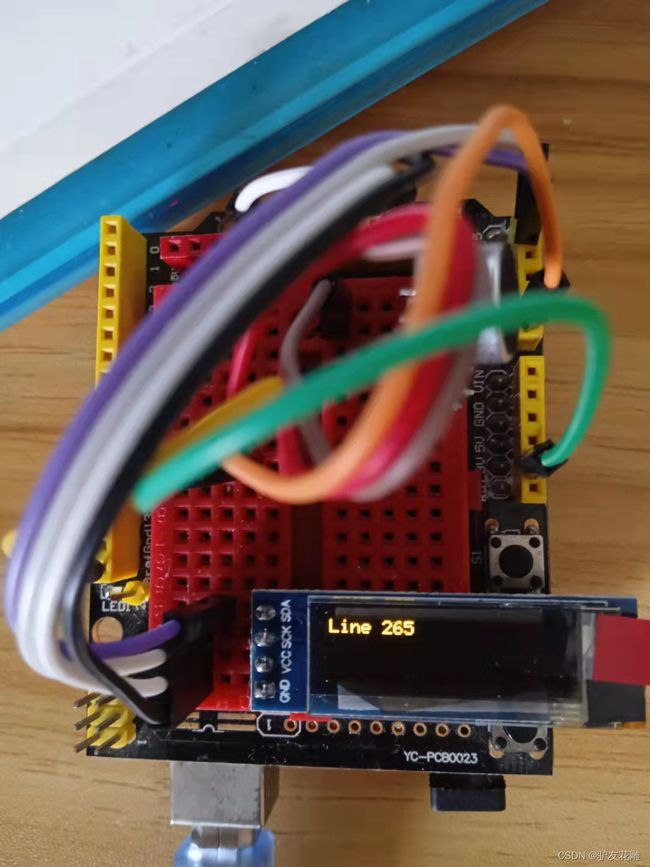
【Arduino】168种传感器模块系列实验(资料代码+仿真编程+图形编程)
实验一百三十六:0.91寸OLED液晶屏显示模块 IIC 12832液晶屏 兼容3.3v-5V
项目二十二:OLED屏显示进度条
实验开源代码
/*
【Arduino】168种传感器模块系列实验(资料代码+仿真编程+图形编程)
实验一百三十六:0.91寸OLED液晶屏显示模块 IIC 12832液晶屏 兼容3.3v-5V
项目二十二:OLED屏显示进度条
实验接线:
oled模块 Ardunio Uno
GND---------GND接地线
VCC---------5V 接电源
SDA---------A4
SCL ------- A5
*/
#include "ssd1306.h"
void setup(){
/* Replace the line below with ssd1306_128x32_i2c_init() if you need to use 128x32 display */
ssd1306_128x32_i2c_init();
ssd1306_fillScreen(0x00);
ssd1306_setFixedFont(ssd1306xled_font6x8);
}
int progress = 0;
void loop(){
ssd1306_drawProgressBar( progress );
progress++;
if ( progress > 100 )
{
progress = 0;
delay( 1000 );
}
else
{
delay( 30 );
}
}
Arduino实验场景图
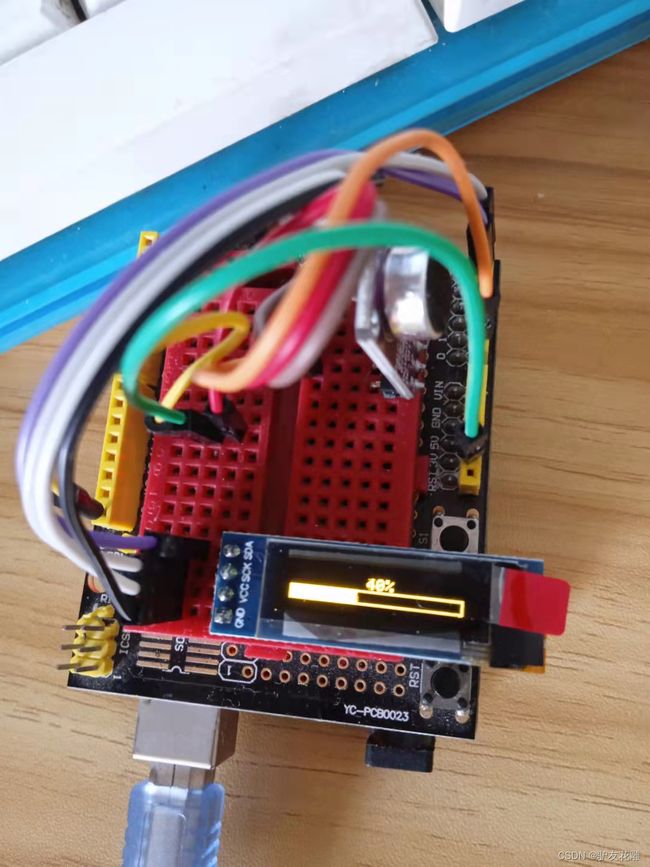
【Arduino】168种传感器模块系列实验(资料代码+仿真编程+图形编程)
实验一百三十六:0.91寸OLED液晶屏显示模块 IIC 12832液晶屏 兼容3.3v-5V
项目二十三:黄色屏声音可视化器
实验开源代码
/*
【Arduino】168种传感器模块系列实验(资料代码+仿真编程+图形编程)
实验一百三十六:0.91寸OLED液晶屏显示模块 IIC 12832液晶屏 兼容3.3v-5V
项目二十三:黄色屏声音可视化器
实验接线: max9814接A0
oled模块 Ardunio Uno
GND---------GND接地线
VCC---------5V 接电源
SDA---------A4
SCL ------- A5
*/
#include "arduinoFFT.h"
#include Arduino实验场景图
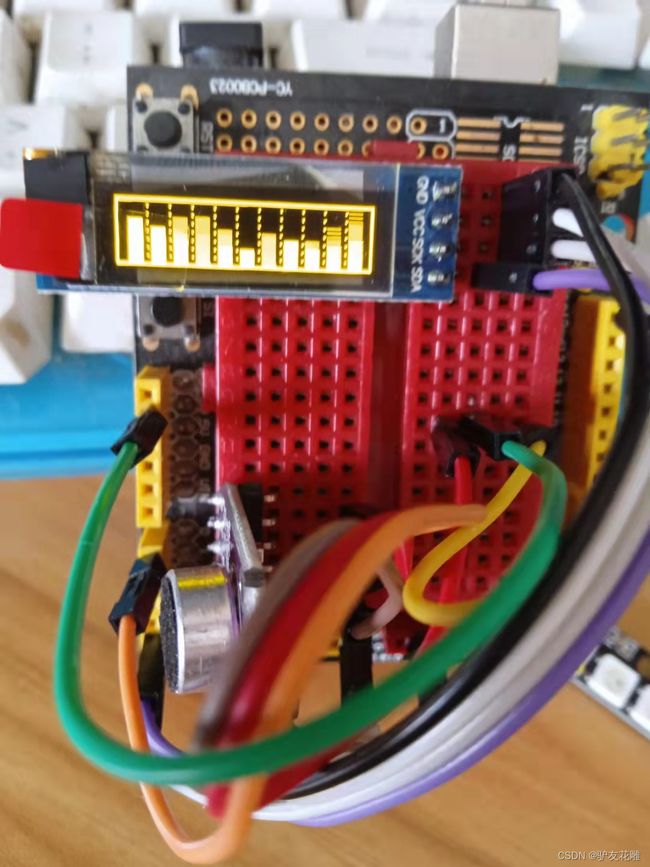

【Arduino】168种传感器模块系列实验(资料代码+仿真编程+图形编程)
实验一百三十六:0.91寸OLED液晶屏显示模块 IIC 12832液晶屏 兼容3.3v-5V
项目二十三:黄色屏声音可视化器
实验视频剪辑
https://v.youku.com/v_show/id_XNTgwODkzMzY3Mg==.html?spm=a2hcb.playlsit.page.1
【Arduino】168种传感器模块系列实验(资料代码+仿真编程+图形编程)
实验一百三十六:0.91寸OLED液晶屏显示模块 IIC 12832液晶屏 兼容3.3v-5V
项目二十四:Arduino OLED 频谱分析仪
实验开源代码
/*
【Arduino】168种传感器模块系列实验(资料代码+仿真编程+图形编程)
实验一百三十六:0.91寸OLED液晶屏显示模块 IIC 12832液晶屏 兼容3.3v-5V
项目二十四:Arduino OLED 频谱分析仪
实验接线:
oled模块 Ardunio Uno
GND---------GND接地线
VCC---------5V 接电源
SDA---------A4
SCL ------- A5
*/
#include Arduino实验场景图

【Arduino】168种传感器模块系列实验(资料代码+仿真编程+图形编程)
实验一百三十六:0.91寸OLED液晶屏显示模块 IIC 12832液晶屏 兼容3.3v-5V
项目二十四:Arduino OLED 频谱分析仪
实验视频剪辑
https://v.youku.com/v_show/id_XNTgwOTAzMzIxNg==.html?spm=a2hcb.playlsit.page.1
【Arduino】168种传感器模块系列实验(资料代码+仿真编程+图形编程)
实验一百三十六:0.91寸OLED液晶屏显示模块 IIC 12832液晶屏 兼容3.3v-5V
项目二十五:简单的文本反转
实验开源代码
/*
【Arduino】168种传感器模块系列实验(资料代码+仿真编程+图形编程)
实验一百三十六:0.91寸OLED液晶屏显示模块 IIC 12832液晶屏 兼容3.3v-5V
项目二十五:简单的文本反转
实验接线:
oled模块 Ardunio Uno
GND---------GND接地线
VCC---------5V 接电源
SDA---------A4
SCL ------- A5
*/
#include Arduino实验场景图
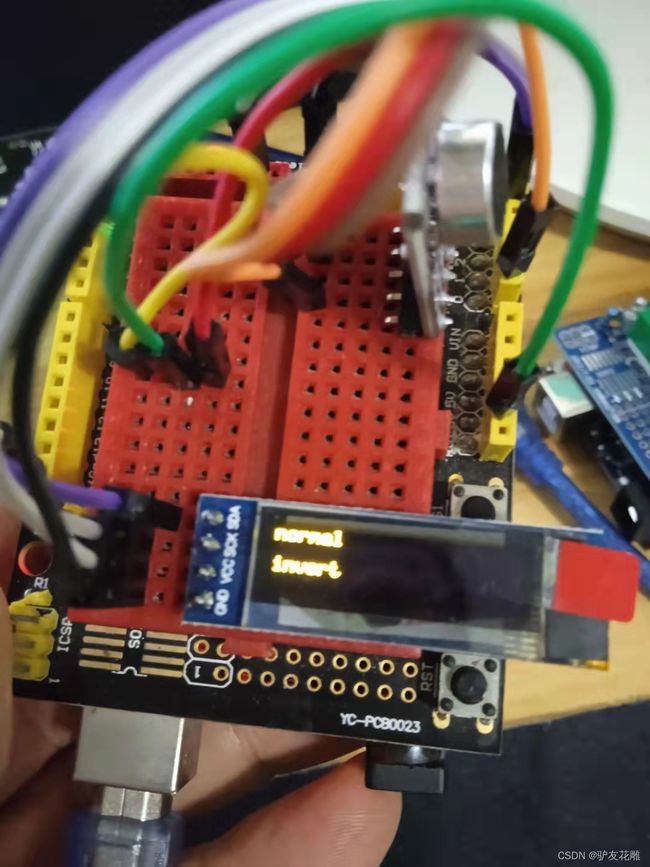
【Arduino】168种传感器模块系列实验(资料代码+仿真编程+图形编程)
实验一百三十六:0.91寸OLED液晶屏显示模块 IIC 12832液晶屏 兼容3.3v-5V
项目二十六:股票行情通过显示器上的一行字段移动文本(横向滚动)
实验开源代码
/*
【Arduino】168种传感器模块系列实验(资料代码+仿真编程+图形编程)
实验一百三十六:0.91寸OLED液晶屏显示模块 IIC 12832液晶屏 兼容3.3v-5V
项目二十六:股票行情通过显示器上的一行字段移动文本(横向滚动)
实验接线:
oled模块 Ardunio Uno
GND---------GND接地线
VCC---------5V 接电源
SDA---------A4
SCL ------- A5
*/
#define RTN_CHECK 1
#include Arduino实验场景图
